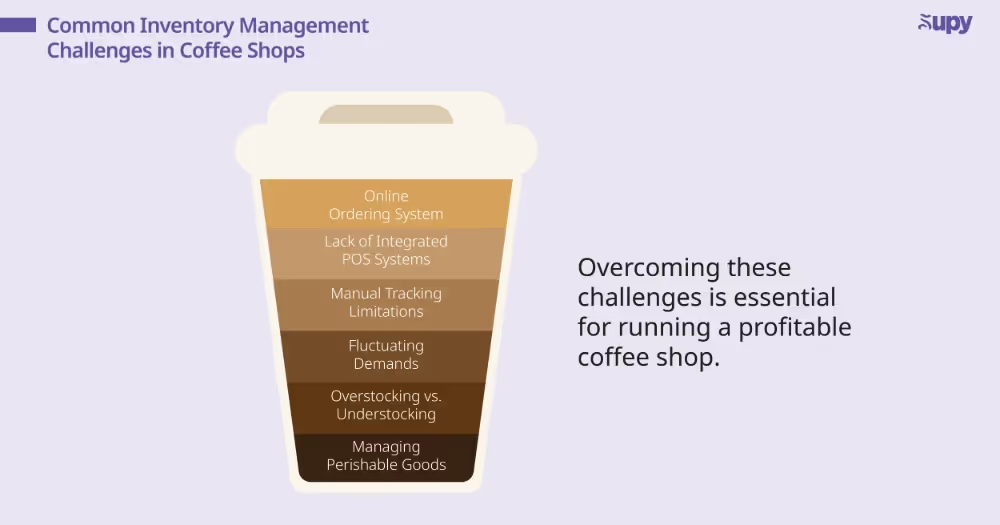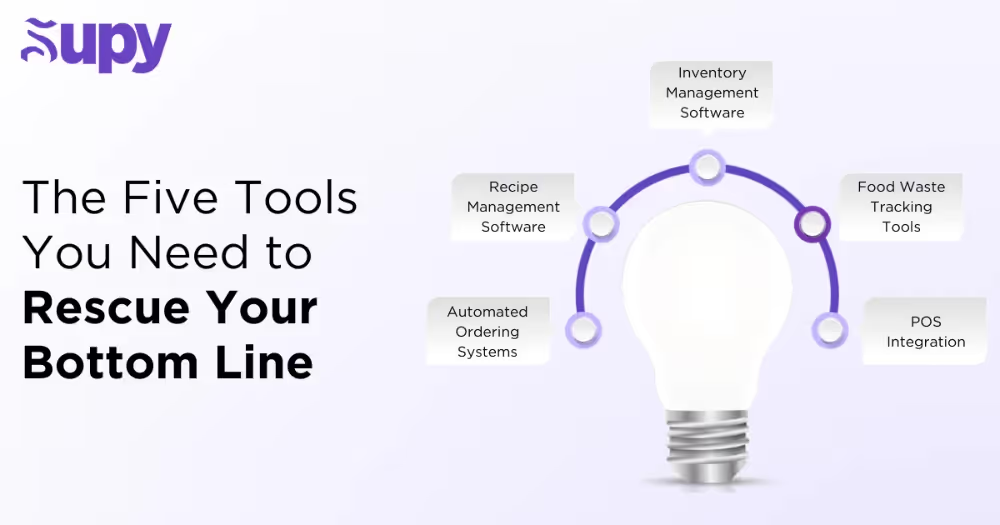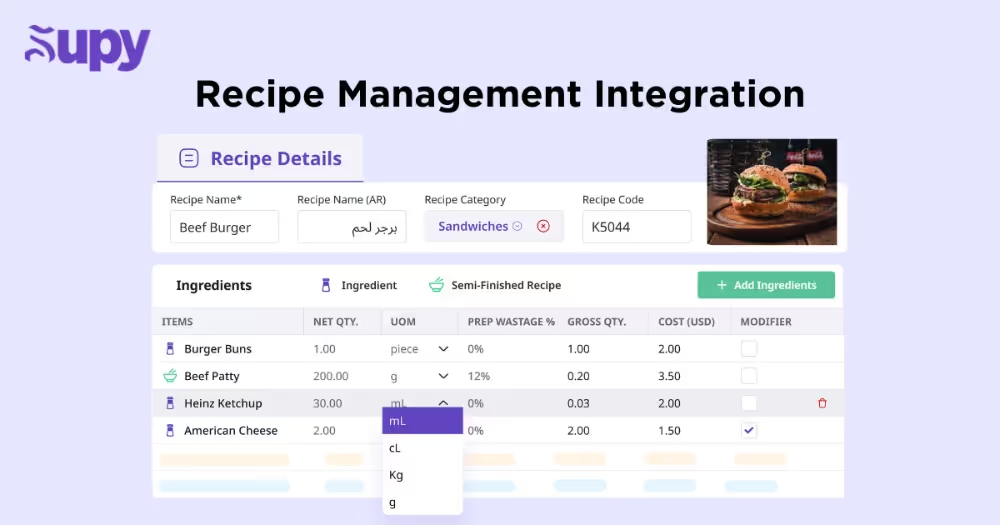Coffee Shop Inventory Management: Tools and Techniques

Running a coffee shop is a lot more than finding the perfect latte recipe and macaroons to pair it with. It's about managing dynamic and fast-paced businesses that often present unique challenges. One of these challenges is inventory management. Coffee shops deal with perishable goods that need to be used up within a few days to maintain quality and reduce waste - and to do that, they need a good inventory management system.
- Unique Challenges of Coffee Shop Inventory Management
- Essential Tools for Coffee Shop Inventory Management
- Effective Techniques for Managing Coffee Shop Inventory
- Reducing Waste and Controlling Costs
- Supplier Management for Coffee Shops
- Real-Life Case Study: Successful Coffee Shop Inventory Management
- Conclusion: Take Control of Your Inventory
But how hard could it be? It's just about keeping track of ingredients and produce. That’s where most restaurants are wrong! Inventory management is undeniably one of the hardest aspects of running an establishment- especially a coffee shop. Bad inventory management leads to wasted food, reduced profits, and issues with menu availability. So, if you’re looking to boost sales and improve your coffee business, you need to shift your attention to how the inventory in your cafe is managed.
Benefits of Inventory Optimization in Coffee Shops
Inventory optimization is the art of managing stock and inventory levels, so supply and demand are balanced. Regularly checking your inventory and identifying how to improve it plays a vital role in ensuring customer satisfaction via menu availability and seamless operations. Optimizing the inventory of a coffee shop has many benefits, some of which include:
- Reducing Waste: Waste reduction is one of the biggest reasons why restaurants move towards inventory optimization. The less produce wasted, the more profits an establishment can make. An unoptimized inventory can, for example, be overstocked with ingredients rotting before they can be used.
- Meeting Customer Demand: Customers tend to avoid going back to coffee shops where their favorite products are often out of stock. Shop owners can avoid this issue by having an optimized inventory that always has ingredients on hand to get orders ready.
- Improving Operational Efficiency: When coffee shops don’t have enough ingredients or too many are stocked up, the operational efficiency of the establishment is affected. Proper inventory management helps streamline things to make running the coffee shop easier.
- Boosting Profits: Lastly, coffee shop owners benefit a great deal from well-kept inventories as they help boost profits. Not only does it minimize the different ways in which inventory-related loss can occur, but it also helps retain customer satisfaction to boost sales.
1. Unique Challenges of Coffee Shop Inventory Management

Managing inventory in a coffee shop may be a need, but it certainly isn’t easy. It comes with its fair share of challenges, especially when tackled manually with basic formulas. If you’re going to overcome these challenges, you’re going to need a lot more than an Excel spreadsheet.
Managing Perishable Goods
Some of the most common ingredients used in coffee shops include cream, milk, fruits, and other perishable goods. These products have a very limited shelf life and are susceptible to storage conditions and temperature changes. Even coffee beans, a generally storable product, tend to lose flavor depending on how long it's stored. Inventory managers need to account for how quickly these ingredients are used up so they don’t stay in storage for too long.
Overstocking vs. Understocking
The hardest task in inventory management is to find the perfect balance between understocking and overstocking. Most people go for the min-max approach, where the mean demand is often catered to when stocking an inventory. But, this doesn’t account for seasonal fluctuations and how business is anything but predictable. Overstocking often consumes capital that can be invested elsewhere, and if the products go bad, it results in loss. Understocking leads to missed sales and customer dissatisfaction, impacting profits.
Fluctuating Demands
Unpredictable demands in coffee shops often lead to over/underestimation of supply. This tends to jumble the inventory requirements, especially when trends, weather, and even traffic can impact demand. For example, although iced drinks are the best sellers in summer - you don’t know if a TikTok trend might make them popular again in the winter. Additionally, peak times like morning hours lead to more demand and increased stock variance. Managing these changes in demand without overstocking or underestimating orders is a big challenge for cafes.
Manual Tracking Limitations
Inventory managers can only go so far with spreadsheets and calculation formulas to budget a proper stock. Many issues with stocking, order, and other inventory tasks come from human errors in calculation. Also, manually keeping up with changes in demand trends, supply chain issues, and all that can be tedious. It's easier for coffee shops to relay this part of inventory management onto automated software that helps with analytics and reports.
Coffee Shop POS System Management
A cafe POS system is an essential part of collecting data from existing customers and their purchasing trends. The latest POS technology helps you integrate the sales system and all the tools needed to manage a better inventory. However, most cafes do not have this technology yet and rely on team management for accurate data entry for analytics. A lack of proper tools and technology is an issue most point-of-sale stations have in such businesses.
Online Ordering System
The cafe and restaurant landscape is changing, with digital menu options taking over for incoming orders placed online. Most coffee shops do not offer customers an easy-to-use online menu that streamlines order placement. Instead, they rely on third-party apps as an all-in-one solution to serve customers digitally.These challenges are just the tip of the iceberg. Based on location, resources, supply chain, and more - coffee shops can have a lot more to deal with. It's important to acknowledge that as businesses grow, relying on technology to streamline difficult processes is the rational decision. There are many management softwares that help cafes get back on track and improve their inventory.
2. Essential Tools for Coffee Shop Inventory Management

As discussed above, there are many restaurant management software that come in handy when it comes to running coffee shops. But Supy stands out from them all with its variety of management features and franchising aid. Whether you’re a coffee shop that’s just starting out or one that’s beginning to branch out - Supy has the tools you need to manage your inventory.
Real-Time Inventory Tracking
Supy’s Inventory Management Software provides real-time analytics so that coffee shop owners always know what their stock levels look like. It helps count stock faster, accounts for any discrepancies, and pulls up charts to show various factors like supply, demand, etc. On average, it helps save 10 hours weekly by reducing the time it takes to manage inventories. Plus, you don’t even have to be actively monitoring the software to stay up to date. For example, if milk stocks run low or too much coffee has been ordered, Supy will send out notifications on what needs to be ordered and what can wait. Supy’s inventory insights offer:
- 80% variance reduction
- 55% food cost reduction
- Up to 10 hours a week saved
Updated Analytics and Reporting
One of the most important aspects of inventory management is accurate reporting and updated analytics to make decisions. Supy provides updated analytics and reporting on various functions like procurement, waste management, variance, sales, menu pricing, and inventory. With the right analytics, coffee shop owners can manage their inventory while boosting sales and profit. Supy’s analytics and reporting feature provides:
- Built-in dashboards for on-spot analytics and reports
- Live data for real-time insights that are regularly updated
- Mobile-friendly interface to make decisions on the go
Customization for Coffee Shops
Supy understands the specific needs that coffee shops have and provides a variety of features to customize operations. Cafe owners can choose from features like recipe optimization, menu engineering, portion control, and pricing. Inventory is only one part of streamlining sales and profit; a good menu and recipe formula is what actually sells the product.It is features like these that make Supy a holistic solution for any issues coffee shop owners may face when running their operations. Unlike other software that is for specific types of franchises, Supy grows with your business. It offers equally essential insights for startup coffee shops as it does for those with multiple locations.
3. Effective Techniques for Managing Coffee Shop Inventory
Now that we know how Supy is a great choice for coffee shop management let’s take a look at the best practices restaurant owners can adopt to improve inventory management:
Track Consumption Trends
Coffee shop owners can benefit from understanding what is selling and what isn’t to better manage their inventory. The only way they can do this is by being caught up with consumption trends and knowing what on their menu isn’t selling. Supy provides you with analytics to understand these trends so you can use them to streamline resource allocation without spending hours on the task.
Set Par Levels
Par levels are the minimum amount of stock a coffee shop keeps to meet customer demands without any ingredients going to waste. Instead of manually computing via the min-max method or using the safety stock theory, Supy makes things easier by analyzing stock usage and determining sub-par levels automatically. If your store typically uses 10 cartons of cream daily, Supy ensures there are always 10 cartons on hand and sets out alerts to maintain par levels when stocks drop.
Schedule Regular Audits
Auditing is essential to understand which ingredients tie down capital and then sink it by going to waste. Plus, it helps keep all your reports functioning in order. Coffee shop owners can schedule regular audits with Supy as it automates stock reviews and generates real-time reports. Regular audits can help cafe owners understand where things are going wrong and make management decisions accordingly.
Focus on High-Margin Items
When coffee shops have an extensive menu, it can be hard to identify high-margin items and best sellers. These items also change with trends, seasons, and demand. Supy takes away hours of manual comparison by keeping track of high-margin items and best sellers in its reports. It highlights which menu items generate the most profit and account for their demand when making inventory requirement lists.
Streamline Inventory Management
Above all, coffee shop owners can use Supy to streamline inventory management. As discussed above, Supy’s inventory management software helps reduce approximately 10 hours of manual work per week. Plus, with automated software, there are fewer chances of error so owners can rest assured the proposed solutions will indeed bring more profit.
Cafe POS Software Integration
Supy is more than an accounting software for coffee shops. It helps provide real-time data for inventory management by integrating with the POS systems at the location. Not only this, but you can link multiple location sales systems to attain holistic input on running a multi-branched cafe. With direct sales input, you know what sells best and prioritize it in your stocking.
4. Reducing Waste and Controlling Costs

Wasted inventory products directly lead to profit loss for restaurants. With coffee shops, the issue is more pronounced as the stock ingredients have a limited shelf life and are more prone to wastage. Supy’s software identifies procurement and use patterns that often lead to wastage and gives you real-time analytics to see the damage being done.But why does reducing waste in coffee shops matter? Reducing waste has a direct connection to controlling costs in a business. Some of the benefits of inventory management to reduce waste include:
- It helps to lower operational costs by minimizing the amount of wasted coffee beans, milk, and other perishable items.
- You get more optimized recipes that make better use of the inventory and go through the stock in a sustainable way.
- Understanding where waste occurs helps find out where resources need to be allocated instead to counter this issue.
- Studying waste patterns allows you to adjust the offered menu and portions to reduce waste while maintaining customer satisfaction.
Not only does Supy identify where wastage is occurring but it also helps propose solutions on how to best manage it. If eclairs aren’t selling well at the end of the day for a noticeable period, Supy will suggest how to trim down the recipe to have a smaller stock of eclairs that meets predictable demands and manages waste.
5. Supplier Management for Coffee Shops
Effective supplier management is the backbone of a well-functioning coffee shop. The supplier is the source of all inventory - and it's essential to have a direct line of communication with suppliers to know they’ll have resources to supply once your inventory begins to run out.The most efficient way to conduct supplier management is to have automated management systems with the contacts of established suppliers. As soon as the system picks up a reduction in certain stocks below critical levels, it places an order for restocking immediately.This eliminates the need for human error and manual input in the inventory stocking process for coffee shops, making functioning streamlined. It also reduces the chances of staff ‘forgetting’ to order more ingredients - which can cause popular menu items to be out of stock.
6. Real-Life Case Study: Successful Coffee Shop Inventory Management
Supy isn’t new to restaurant management! Many coffee shops have benefited from its inventory management software, and The Coffee Address in Saudi Arabia is just one of them. Established in 2011, this store has become a hit in the country with around 140 different locations. It faced many inventory management issues when expanding branches and partnered with Supy to find a solution.The Coffee Address implemented a number of recommendations by Supy. The management software helped them to:
- Consistently track stock counts
- Get updated sales data directly from the POS
- Establish direct data entry
- Improve stock ordering and management
- Make quicker inventory decisions with analytics
These highlighted areas and suggested policies helped The Coffee Address reduce waste drastically and cut costs by around 25%. With around 100 hours saved monthly, the staff was free to focus on other matters at hand, and the overall profitability of the coffee shop grew. Just like The Coffee Address, you can make your own coffee shop do better in such a competitive market!
7. Conclusion: Take Control of Your Inventory
Running a successful coffee shop shouldn't be as hard as everyone makes it to be. With the proper tools and team by your side, you can streamline important processes like menu engineering, inventory management, and waste reduction. Making a profit from a coffee shop business isn't a one-formula-fits-all situation, it requires a store owner to consider a multitude of factors.If you're having trouble trying to stay on top of inventory stocking and reports, let Supy take over for you. It's a reliable tool with a proven track record of helping coffee shops perform better.Interested in improving your coffee shop business? Schedule a demo with Supy and see the difference for yourself!Supy is a restaurant inventory management software platform that can help coffee shops with one or multiple locations improve their stocks and reduce waste. Along with inventory management, it has other features like menu engineering, regular sales updates, real-time analytics, and input for waste reduction.Having Supy as a partner helps restaurant owners stay informed of important facts and figures that they tend to overlook. It's the go-to tool if you want to grow your business and profits in such a competitive landscape.If you’re looking to expand your cafe, check out this insightful ebook on The Ultimate Guide to Opening a Central Kitchen for Multi-Branch F&B Businesses.
Related Resources







